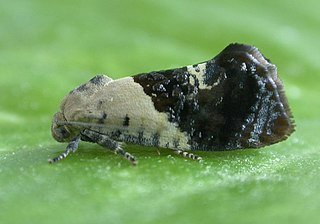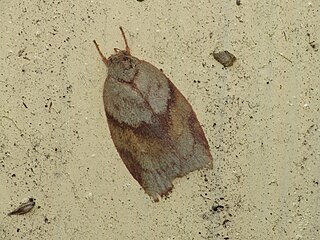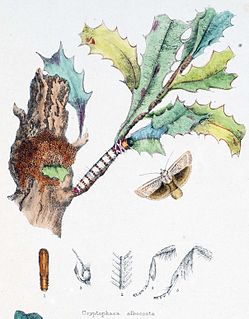Related Research Articles

Plectophila discalis is a moth of the family Xyloryctidae first described by Francis Walker in 1865. It is found in Australia, where it has been recorded from New South Wales, Queensland and Victoria.

Hypertropha chlaenota is a species of moth of the family Depressariidae first described by Edward Meyrick in 1887. It is found in Australia, where it has been recorded from Victoria, Queensland, New South Wales, the Australian Capital Territory and South Australia.

Lichenaula lichenea is a species of moth of the family Xyloryctidae. It is known in Australia from the Australian Capital Territory, New South Wales and Queensland.

Izatha apodoxa is a moth of the family Oecophoridae. It is endemic to New Zealand, where it is known from scattered localities in the southern North Island. This species is variable in appearance and comes in two forms, a grey form and a black and white form. In the grey form it is very similar in appearance to I. notodoxa and in the black and white form to I. katadiktya. At present the larvae and biology of this species is unknown.
Samea antisema is a moth in the family Crambidae. It was described by Edward Meyrick in 1886. It is found on Vanuatu.
Cryptolechia callixyla is a moth in the family Oecophoridae. It was described by Edward Meyrick in 1888. It is found in New Zealand.

Euchaetis crypsichroa is a moth in the family Oecophoridae. It was described by Oswald Bertram Lower in 1893. It is found in Australia, where it has been recorded from South Australia.
Catacometes hemiscia is a moth in the family Oecophoridae. It was described by Edward Meyrick in 1883. It is found in Australia, where it has been recorded from New South Wales.
Garrha costimacula is a moth in the family Oecophoridae. It was described by Edward Meyrick in 1883. It is found in Australia, where it has been recorded from Queensland and New South Wales.
Anisoplaca achyrota is a species of moth in the family Gelechiidae. It was described by Edward Meyrick in 1886. It is endemic to New Zealand.
Athrips profusa is a moth of the family Gelechiidae first described by Edward Meyrick in 1921. It is found in Zimbabwe.
Clerarcha grammatistis is a moth in the family Xyloryctidae. It was described by Edward Meyrick in 1890. It is found in Australia, where it has been recorded from Western Australia.

Cryptophasa albacosta, the small fruit tree borer, is a moth in the family Xyloryctidae. It was described by John Lewin in 1805. It is found in Australia, where it has been recorded from New South Wales, Queensland, South Australia, Tasmania and Victoria.
Lichenaula laniata is a moth in the family Xyloryctidae. It was described by Edward Meyrick in 1890. It is found in Australia, where it has been recorded from New South Wales and Queensland.
Enchocrates glaucopis is a moth in the family Depressariidae. It was described by Edward Meyrick in 1883. It is found in Australia, where it has been recorded from the south-east of the country.
Scorpiopsis pyrobola is a moth in the family Depressariidae. It was described by Edward Meyrick in 1887. It is found in Australia, where it has been recorded from Queensland and New South Wales.
Cerconota ebenocista is a moth in the family Depressariidae. It was described by Edward Meyrick in 1928. It is found in French Guiana.

Phylomictis maligna is a moth in the family Depressariidae. It was described by Edward Meyrick in 1890. It is found in Australia, where it has been recorded from Victoria.
Moca aphrodora is a species of moth in the family Immidae first described by Edward Meyrick in 1922. It is found in Brazil and Peru.

Asaphodes cosmodora is a species of moth in the family Geometridae. This species is endemic to New Zealand.
References
- ↑ Beccaloni, G.; Scoble, M.; Kitching, I.; Simonsen, T.; Robinson, G.; Pitkin, B.; Hine, A.; Lyal, C., eds. (2003). "Euchaetis endoleuca". The Global Lepidoptera Names Index . Natural History Museum . Retrieved May 24, 2018.
- ↑ Savela, Markku, ed. (12 July 2014). "Euchaetis endoleuca Meyrick, 1888". Lepidoptera and Some Other Life Forms. Retrieved 29 August 2020.
- ↑ Proceedings of the Linnean Society of New South Wales. (2) 2 (4): 938.
| This article on a moth of the family Oecophoridae is a stub. You can help Wikipedia by expanding it. |